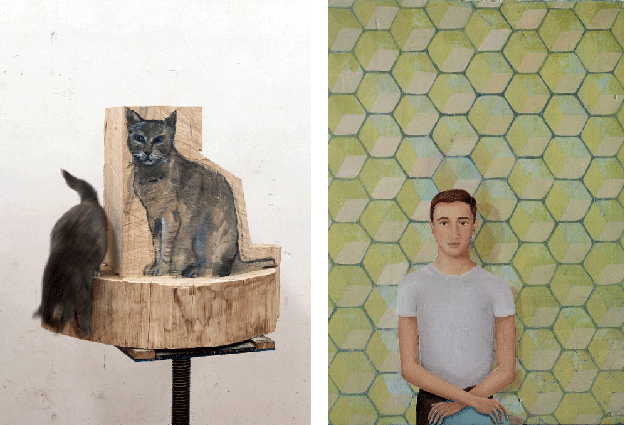Stephan Balkenhol | Project Room – Marie Rosen

Mostra personale di Stephan Balkenhol nello spazio principale e di Marie Rosen nella project room.
Comunicato stampa
Stephan Balkenhol
Monica De Cardenas is delighted to announce an exhibition of new works by German artist Stephan Balkenhol.
Since more than twenty years Balkenhol has been breathing new life into figurative sculpture with intense and original work. After leaving the Hamburg Academy, where he studied with the German minimalist sculptor Ulrich Rückriem, Balkenhol soon discovered his preference for wood as a material and his interest in wanting to reinvent the figure.
The human figure, animals, and recently also architecture and landscapes, are the motifs Balkenhol chooses for his sculptures and reliefs. He gouges them out of a tree trunk, and the traces left by the tools, branch notches and splits in the wood are left visible. Paint is used in a reduced form to structure the sculptures. Gestures, poses and facial expressions suggest both inner distance and an attentive openness towards the viewer. Balkenhol's figures are not lively "storytellers". Instead the artist seeks to condense human physiognomy and appearance, with the result that his figures seem unpretentious, unobtrusive and simultaneously removed from time: "I don't want talkative, expressive figures, which is why I seek an open expression from out of which all states are possible." The openness of his figures, the absence of gesture and a narrative context is a counter reaction to a deliberately present-oriented or illustrative figuration that may well address an individual aspect but, being a kind of instantaneous take, would restrict all other possible interpretations. By turning to themes of everyday in his sculptures, relief and installations, the artist has fathomed new aesthetic dimensions - also in the public domain and in the context of architecture - and thereby made new options available for contemporary sculpture.
He is undoubtedly one of the most prominent sculptors of our time. Since 1992 he has been a professor at the State Academy of the Arts in Karlsruhe, and divides his time between Germany and Meisenthal, France. Balkenhol has created many public works, among these the new Richard Wagner Memorial in Leipzig in May 2013; a large-scale presentation at the Church of Saint Elizabeth in Kassel in 2012 and the monumental sculpture of a male torso shown at the Fori Imperiali in Rome in 2010.
Since the late 1980s he has shown extensively in European and American galleries and museums, among these in recent years at the Museè de Grenoble in 2010, Deichtorhallen Hamburg in 2008-2009, Museum der Moderne Salzburg and Padiglione dArte Contemporanea Milano in 2007, Staatliche Kunsthalle Baden-Baden in 2006, National Museum of Art of Osaka in 2005, Sprengel Museum of Hannover in 2003.
Project Room: Marie Rosen
In the Project Room we present the young Belgian painter Marie Rosen, born in Bruxelles in 1984. Marie Rosens small works, painted in oil on wooden panels, depict figures in interiors, plants and objects or landscapes strangely animated by an uncanny atmosphere. At first sight they seem simple and straight forward, but they hide surprising complexity.
The delicate nature of Rosens paintings is reinforced by the deliberately small format. They are painted on wooden panels whose corners are rounded off and sometimes also trimmed a bit. The wood recalls Byzantine icons. Apart from the Byzantine influence, there are also echoes of Gothic painting as in the way in which the figures are separate from the background and are depicted in a flat way, without much perspective. When Rosen depicts her figures in a natural landscape, the latter is presented in a stylized way without much in the way of detail. In a few cases, however, there is a more elaborate background of geometric or floral motifs. At the same time, Rosen counters the delicacy of her paintings by sometimes scraping the wooden panels, which gives her paintings a rawer edge. Rosen succeeds in absorbing her diverse art-historical references into a distinctive style of her own.



